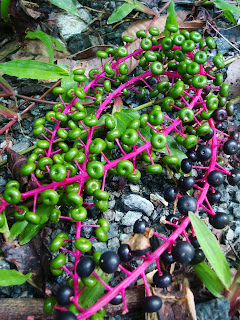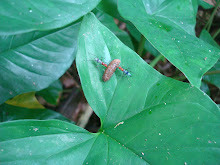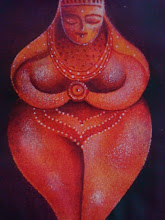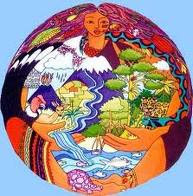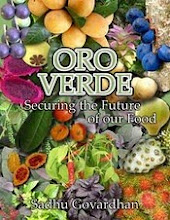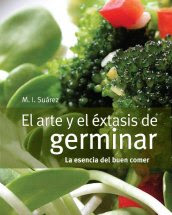22.9.13
Y finalmente la piña….dulce/Finally a pineapple….sweet
20.3.13
Boa Constrictora / Constrictor Boa
17.2.13
Cariaquillo / Lantana camara
Archaeoprepona demophoon insulicola
16.2.13
Piñas / Pineapples
10.12.12
Kudzu Tropical (Pueraria phaseoloides)
9.11.12
23.10.12
Guineo Ornamental / Pink Flowering Banana (Musa ornata)
Gracias Brian Irish (TARS
19.10.12
Hongos extraños / Rare Fungi
Dhatūrā / Devil’s Trumpets
12.10.12
Semillas de Libertad / Seed Freedom
9.10.12
Lirio “Candelaria” - Hippeastrum Amarylidoceae
The sun is here; the lilies woke up. Thanks Doña María for donating these lilies to Pachamama.
21.9.12
Guineos Niños / Bananas “Niños”
27.8.12
Las semillas son vida / Seeds Are Life
 “El deseo de preservar semillas viene de una urgencia ética para defender la evolución de la vida” dijo Vandana Shiva, autora y estudiosa.
“El deseo de preservar semillas viene de una urgencia ética para defender la evolución de la vida” dijo Vandana Shiva, autora y estudiosa."The desire to save seeds comes from an ethical urge to defend life's evolution" says Vandana Shiva, activist, author and scholar.
http://www.google.com/url?q=http%3A%2F%2Fwww.nextworldtv.com%2Fpage%2F4105.html&sa=D&sntz=1&usg=AFQjCNEpr9oRZX9ZMb7pIVIliLyTTe6ZrQ
17.8.12
!Ahora es que es!/ Now it’s the time!
 Estamos en plena temporada de lluvia. En el Oeste de la isla esta lloviendo casi todas las tardes. Para los que sembramos y vivimos en las zonas rurales del tropico humedo, esta temporada trae muchos retos en el diario vivir, sobretodo en las fincas manejadas ecologicamente.
Estamos en plena temporada de lluvia. En el Oeste de la isla esta lloviendo casi todas las tardes. Para los que sembramos y vivimos en las zonas rurales del tropico humedo, esta temporada trae muchos retos en el diario vivir, sobretodo en las fincas manejadas ecologicamente.La abundancia de la lluvia alimenta cada planta, cada organismo vivo y todo crece sin abonos o composta. Los machetes no dan a vasto para la competencia con los bejucos y las malezas que crecen sin control. Es el tiempo de observar la naturaleza.
15.8.12

Nuestro agradecimiento a Deborah J. Lodge y Sharon Cantrell, expertas en micología caribeña (tropical) por ayudarnos a identificar algunos de los hongos encontrados en esta temporada en Pachamama.
Thanks so much to Deborah J. Lodge and Sharon Cantrell, Caribbean mycology (tropical) experts for helping us to identify some of the fungi found during this season at Pachamama.
9.8.12
Hermosas y deliciosas/Beautiful and Delicious
Not everything is rain in the West coast of Puerto Rico! Thanks Ian Crown for the invitation to taste these beautiful and delicious fruits of this season.
31.7.12
Juan de Vargas alias “bejuco de paloma”
29.7.12
En honor a la unidad / Honoring Unity
During the last days many groups around the world –including Puerto Rico- had being celebrating and honoring a prophetical cosmic phase first announced in the past by few tribes. The call was listened and now we should have continued working and collaborating to the common good and the conscious evolution.
17.7.12
Dictyphora indusiata / Velo de Novia
Fungi in the Jungle
18.6.12
Pacholí/Patchouli (Vetiver) Chrysopogon zizanioides (L.)
The hillside ditch that we recently finished need two rows of patchouli (vetiver). This plant is very important to avoid the erosion a common problem in tropical soils. The uses of this grass include water conservation, flood control and restoring the land among other uses. The two rows of vetiver are planted to the contour at six inches of distance. The purpose of this practice is to create a protected barrier that will reduce the water flow as well to retain the sediments. Here Kalani Saldaña working on it. Thanks to Mariel y Ramón de Conuco del Cotto in San Germán; Fello Pérez de Siembra para tod@s in Cabo Rojo and Raquel Robledo which donated the vegetative material in order to complete this phase of the project.
13.4.12
Zanja de ladera / Hillside Ditch
 Luego de cavar una zanja de ladera de unos 115 pies de largo hemos comenzado a notar una mejoría inmediata en uno de los predios de siembra de Pachamama. Gracias a la asistencia y asesoría de la agrónoma Raquel Robledo de NRCS, estamos controlando un gran flujo de agua que baja de los cerros hacia el llano donde estamos sembrando. El diseño al contorno de la zanja se unió a uno de nuestros mas notables problemas: el antiguo camino creado por los vehículos de todo terreno (4x4). Este camino comenzó a regenerarse y en menos de un año la vegetación ha crecido protegiendo así, las zonas erosionadas y maltratadas por las motoras y los “four tracks”.
Luego de cavar una zanja de ladera de unos 115 pies de largo hemos comenzado a notar una mejoría inmediata en uno de los predios de siembra de Pachamama. Gracias a la asistencia y asesoría de la agrónoma Raquel Robledo de NRCS, estamos controlando un gran flujo de agua que baja de los cerros hacia el llano donde estamos sembrando. El diseño al contorno de la zanja se unió a uno de nuestros mas notables problemas: el antiguo camino creado por los vehículos de todo terreno (4x4). Este camino comenzó a regenerarse y en menos de un año la vegetación ha crecido protegiendo así, las zonas erosionadas y maltratadas por las motoras y los “four tracks”.Las lluvias de marzo / Rains during March
 El pasado mes de marzo -en la zona Oeste de la isla- se registraron sobre 10” de lluvia en una temporada que normalmente es de sequía. Esto es una bendición y también una complicación para los agricultores.Los patrones de lluvia en los últimos tres años indican cambios climáticos que no debemos seguir ignorando. Aquí la última crecida del Río Casey.
El pasado mes de marzo -en la zona Oeste de la isla- se registraron sobre 10” de lluvia en una temporada que normalmente es de sequía. Esto es una bendición y también una complicación para los agricultores.Los patrones de lluvia en los últimos tres años indican cambios climáticos que no debemos seguir ignorando. Aquí la última crecida del Río Casey.Past March –in the West Coast of the island- we registered over 10” of rain in a season that is usually dry. This is a blessings but also a complication for farmers. The patterns of rain in the last three years indicate climatic changes that we can not longer ignore. Here the last flood of Casey River.
1.4.12
Taller de Arcillas / Potter's Clay Workshop
 Puerto Rico posee una gran variedad de suelos que varían de acuerdo a la ubicación geográfica. Las características y texturas del suelo indican sus posibles usos. En las últimas semanas, Kalani Saldaña (Voluntario Residente), ha comenzado a identificar los distintos tipos de suelos en Pachamama con varios fines. Uno de ellos es realizar un taller de arcillas probablemente a final de este año. Si le interesa este taller puede escribirnos o llamarnos para reservar su espacio pues son limitados. El costo será por donación y/o intercambio (a determinarse proximamente).
Puerto Rico posee una gran variedad de suelos que varían de acuerdo a la ubicación geográfica. Las características y texturas del suelo indican sus posibles usos. En las últimas semanas, Kalani Saldaña (Voluntario Residente), ha comenzado a identificar los distintos tipos de suelos en Pachamama con varios fines. Uno de ellos es realizar un taller de arcillas probablemente a final de este año. Si le interesa este taller puede escribirnos o llamarnos para reservar su espacio pues son limitados. El costo será por donación y/o intercambio (a determinarse proximamente).Puerto Rico has a great variety of soils that are different according their geographical location. The characteristics and textures of the soils indicate their possible uses. In the last weeks, Kalani Saldaña (Resident Volunteer), started to identify the different types of soil in Pachamama for various purposes. One of them is to organize a potter’s clay workshop at the end of this year. If you are interested in this class you can send us a message or call to reserve your spaces which are limited. Cost will be by donation and/or exchange (to be determined soon).
31.3.12
Joel Alejandro y los liquenes / Joel Alejandro and the Lichens
 Gracias Joel Alejandro por traer a Mayaguez esta charla y compartir tu conocimiento sobre esta interesante simbiosis. Ojalá que todos los participantes hayan absorbido tan valiosa información.
Gracias Joel Alejandro por traer a Mayaguez esta charla y compartir tu conocimiento sobre esta interesante simbiosis. Ojalá que todos los participantes hayan absorbido tan valiosa información.20.3.12
Liquenes de Puerto Rico
 Charla: Los Líquenes: Elementos olvidados de la biodiversidad puertorriqueña Joel A. Mercado-Díaz, Liquenólogo, Instituto Internacional de Dasonomía Tropical
Charla: Los Líquenes: Elementos olvidados de la biodiversidad puertorriqueña Joel A. Mercado-Díaz, Liquenólogo, Instituto Internacional de Dasonomía TropicalAuditorio del Museo Eugenio María de Hostos
Carr. 354, Camino Los Ortiz, Km. 3.8
Bo. Río Cañas Arriba
Mayagüez, Puerto Rico
Para detalles de la actividad e información de cómo llegar al museo visite: http://www.facebook.com/events/180835655366854/#!/events/180835655366854/
2.3.12
Jergón Sacha o Hierba de Jergón
 Gracias a Juana Pérez, Zorayma Navarro, O’Nell González y Brian Brunner por ayudarme a identificar esta planta que nació de la “nada” en Pachamama.
Gracias a Juana Pérez, Zorayma Navarro, O’Nell González y Brian Brunner por ayudarme a identificar esta planta que nació de la “nada” en Pachamama.Thanks to Juana Pérez, Zorayma Navarro, O’Nell González and Brian Brunner for helping me to identify this plant that born out of “nothing” in Pachamama.
Para información sobre esta planta de la Amazonía, favor de visitar el enlace siguiente: http://www.rain-tree.com/jergon.htm
For information about this Amazonian plant, please visit the following link: http://www.rain-tree.com/jergon.htm
22.1.12
Brigada Boricua en Pachamama
 El pasado viernes 20 de enero un grupo de jovenes emprendedores y comprometidos con la tierra nos visitaron y prestaron sus manos, experiencia y solidaridad para adelantar los trabajos en Pachamama. Le agradezco con el alma este esfuerzo. Gracias a Erik, Fello y Shaisa, Juaco y Juanita, Nano, Gema, Augusto y Ubek, Ricardo, Vivi, Inti y Anuk, Luis y Lynnette, Juanma y Mariolga, Kalani, Doralis, Brenda, Angeles y Liz. Hasta la proxima brigada!
El pasado viernes 20 de enero un grupo de jovenes emprendedores y comprometidos con la tierra nos visitaron y prestaron sus manos, experiencia y solidaridad para adelantar los trabajos en Pachamama. Le agradezco con el alma este esfuerzo. Gracias a Erik, Fello y Shaisa, Juaco y Juanita, Nano, Gema, Augusto y Ubek, Ricardo, Vivi, Inti y Anuk, Luis y Lynnette, Juanma y Mariolga, Kalani, Doralis, Brenda, Angeles y Liz. Hasta la proxima brigada!Past friday January 20th, a group of young adults highly committed to the Earth came and help with their hands, experience and solidarity helping us to continue the progress in Pachamama. Thanks for this effort. In the group: Erik, Fello y Shaisa, Juaco y Juanita, Nano, Gema, Augusto y Ubek, Ricardo, Vivi, Inti y Anuk, Luis y Lynnette, Juanma y Mariolga, Kalani, Doralis, Brenda, Angeles, Oliva y Liz.
15.1.12
Bienvenido Kalani / Welcome Kalani
 Le damos la bienvenida a nuestro voluntario residente Kalani Saldaña. Las talas y los jardines estan avanzando gracias a su constante dedicación y creatividad. Gracias por colaborar y aceptar ser parte de este proyecto! Para una muestra de sus pinturas visite: http://www.galeriaveve.com/saldana.html
Le damos la bienvenida a nuestro voluntario residente Kalani Saldaña. Las talas y los jardines estan avanzando gracias a su constante dedicación y creatividad. Gracias por colaborar y aceptar ser parte de este proyecto! Para una muestra de sus pinturas visite: http://www.galeriaveve.com/saldana.htmlWe welcome our resident volunteer Kalani. The clearing and the gardens are getting into shape thanks to his constant dedication and creativity. Thanks for collaborate and accept to be part of this project! To see a sample of his paintings visit: http://www.galeriaveve.com/saldana.html
9.12.11
Despues de la lluvia / After the Rain
 La pasada temporada de lluvia fue intensa y prolongada en la zona oeste. Los vientos de Irene causaron el desprendimiento de muchas ramas. La vegetación cubrió casi todas las veredas del bosque jardín. Nos encontramos en la segunda fase del primer ciclo de desarrollo de bajo impacto y tenemos trabajo como es. ¿Te animas a darnos una manito? Escribe o llama y con gusto te acomodaremos en el itinerario de voluntari@s. Espacios limitados.
La pasada temporada de lluvia fue intensa y prolongada en la zona oeste. Los vientos de Irene causaron el desprendimiento de muchas ramas. La vegetación cubrió casi todas las veredas del bosque jardín. Nos encontramos en la segunda fase del primer ciclo de desarrollo de bajo impacto y tenemos trabajo como es. ¿Te animas a darnos una manito? Escribe o llama y con gusto te acomodaremos en el itinerario de voluntari@s. Espacios limitados.The past rainy season was intense and long in this zone. The winds that Irene brought caused the falling of many branches. The vegetation covered almost all trails in the forest garden. We are now in the second phase of the first cycle of low impact development and we have plenty of work to do! Do you want to give us a hand? Please write or call and we will gladly accommodate you in the schedule available for volunteers. Limited spaces.
13.11.11
Derrumbes en Pachamama / Landslides in Pachamama
 El bosque jardín Pachamama fue impactado por maquinarias industriales y por ideas de “progresistas” hace veinticinco años o más. Debido a la topografía, la localización, los tipos de suelo y otras características que responden al trópico húmedo, a medida que trabajamos en el desarrollo holístico adecuado para esta finca, también vamos corrigiendo las consecuencias negativas de los errores humanos y los equipos pesados. Algunas de las consecuencias directas van desde la pérdida de nutrientes hasta la compactación del terreno, lo cual causa escorrentía y erosión, entre otros problemas.
El bosque jardín Pachamama fue impactado por maquinarias industriales y por ideas de “progresistas” hace veinticinco años o más. Debido a la topografía, la localización, los tipos de suelo y otras características que responden al trópico húmedo, a medida que trabajamos en el desarrollo holístico adecuado para esta finca, también vamos corrigiendo las consecuencias negativas de los errores humanos y los equipos pesados. Algunas de las consecuencias directas van desde la pérdida de nutrientes hasta la compactación del terreno, lo cual causa escorrentía y erosión, entre otros problemas.Los resultados de re-diseñar la forma natural de los terrenos pueden ser impredecibles, especialmente, cuando ignoramos sus características únicas. Los terrenos en el trópico son frágiles y propensos a la erosión aún cuando estos no sean impactados intencionalmente. Esta es la razón por la que debemos tomarnos el tiempo para estudiar y explorar los pros y los contras, antes de considerar la utilización de maquinarias industriales, tales como explanadoras o “puercas”. Tan pronto los terrenos son impactados por estos equipos queda una huella permanente y con ésta, múltiples consecuencias a largo plazo.
Una consecuencia directa de los impactos al terreno no planificados son los derrumbes. Un problema creado en el pasado por la falta de conocimiento y problamente, por el afan de explotar la tierra como ha sido el uso y costumbre a partir del auge de la industrialización* que comienza intensamente en la Isla a partir de la década de los cuarenta.
A finales de esa década, la mayor parte de los bosques primarios de Puerto Rico fueron impactados con el fin de uso agrícola y posteriormente para el desarrollo de viviendas y centros comerciales. Muchos de los modelos de desarrollo propuestos en ese entonces, no tomaban en cuenta la conservación de los suelos, la protección de los recursos naturales y mucho menos, la simbiosis o conexión entre el ser humano y la naturaleza.
La poca actividad agrícola en las últimas décadas permitió un estado de reposo a la tierra lo que ha permitido el renacimiento de los bosques (secundarios). Esto representa –en mi opinión- una segunda e increible oportunidad para re-aprender sobre como podemos utilizar los bosques con sensibilidad e inteligencia, a la vez que los sembramos, usamos y protegemos.
Estudiosos de la ecología y otros campos de estudios relacionados, han confirmado que existen prácticas convencionales que han causado mucho daño al ambiente en general. Ahora, lo que procede, es la integración y aplicación de todo conocimiento –antiguo o moderno- que proponga restablecer parte de la armonía natural que ha sido destruída por el progreso, la explotación, la comodidad, la ambición y la ignorancia.
(*El proceso de industrialización ha sido un contínuo a partir del movimiento colonizador Europeo.)
“La naturaleza es sagrada porque es ella la que provee lo que necesitamos para subsistir”. Doña Vitta
The Pachamama forest garden was impacted by industrial machines and the ideas of “progressive” people about twenty-five years ago or more. Due to its topography, location, soil types and other characteristics that belong to the humid tropics, as we are working on the proper holistic development of this project, we also have to correct the negative consequences of human error and big machines. Examples run from nutrient depletion to compacted soil, which causes water runoff and erosion, among many other problems.
Re-designing the natural shape of land involves many unpredictable results especially, when we ignore their unique characteristics. The soils in the tropics are fragile and are prone to erosion even when they are not impacted by heavy equipment. This is the main reason why we have to take the time to study and explore the pros and cons before consider using heavy machinery, such as bulldozers. Once the land is impacted by any equipment, there is a permanent footprint left, the consequences that could bring multiple long term problems.
One direct consequence, due to the lack of planning and consideration of these impacts are landslides. This problem was created in the past by the absence of knowledge and probably, by the desire to exploit nature as was the use and custom since industrialization* came to the island, around de decade of the forties.
The limited agricultural activity in the past decades has allowed a resting period for the land that has facilitated the growing of novelle new forests island wide. In my opinion, this represents an incredibly important opportunity to re-learn how to wisely use and protect our new forests at the same time that we sensitively and intelligently integrate agricultural practices.
By the end of that decade, most of the primary forests of Puerto Rico were clear cut for agricultural use and later, for the development of housing and commercial malls. Most of the proposed development models of that time did not consider soil conservation, the protection of natural resources and least of all the symbiosis between humans and nature.
Ecology’s scholars as well as experts from other related fields have confirmed that there are conventional practices that have caused, and continue to cause much harm {in general} to our environment. Now, what needs to proceed is the integration and application of all knowledge –old and new- that propose the re-establishment of some part of the destroyed natural harmony due to progress, exploitation, comfort, ambition and ignorance.
(*The industrialization process in a continuum that started with the European colonizing movement.)
“Nature is sacred because it provides us with what we need to subsist.” Doña Vitta
7.7.11
IFFF en Puerto Rico
 A partir del mes de julio y en un esfuerzo colaborativo entre distintas organizaciones en Puerto Rico, estaremos presentando el Festival Internacional de Cine Forestal (IFFF / International Forest Film Festival). Esta muestra se esta presentando simultáneamente en distintos paises como parte de las actividades del Año Internacional de los Bosques (2011). Los interesados en participar pueden escribirme a jardinpachamama@gmail.com o puede llamarme al (787) 313-3389 para coordinar futuras presentaciones en su organización o comunidad. Gracias por su apoyo.
A partir del mes de julio y en un esfuerzo colaborativo entre distintas organizaciones en Puerto Rico, estaremos presentando el Festival Internacional de Cine Forestal (IFFF / International Forest Film Festival). Esta muestra se esta presentando simultáneamente en distintos paises como parte de las actividades del Año Internacional de los Bosques (2011). Los interesados en participar pueden escribirme a jardinpachamama@gmail.com o puede llamarme al (787) 313-3389 para coordinar futuras presentaciones en su organización o comunidad. Gracias por su apoyo.
25.5.11
Piedras en el camino / Stones in my way

26.4.11
Pachamama nos llama / Pachamama is calling
 ÚNETE A PACHAMAMA BOSQUE-JARDÍN
ÚNETE A PACHAMAMA BOSQUE-JARDÍNPachamama Bosque-Jardín es un espacio para facilitar la re-conexión con la naturaleza tropical. Es un bosque “nuevo” o secundario de trece cuerdas de terreno, ubicado en las Montañas de Urayoán entre Mayagüez, Añasco y Las Marías.
El proyecto Pachamama es un modelo de bajo impacto ambiental y una finca familiar sustentable en progreso. Los conceptos que estamos aplicando provienen de: la agroecología, la agroforestería, la silvicultura, la permacultura y la agricultura holística y de conservación.
En esta etapa inicial estamos primordialmente trabajando en la remoción de árboles caídos, en la exploración del bosque para abrir veredas, levantando inventarios de la flora y la fauna, seleccionando los cultivos apropiados y desarrollando un plan de manejo de recursos naturales y de conservación de la biodiversidad. Además, nos encaminamos hacia la siembra ecológica de cultivos comibles para la subsistencia. De esta manera, queremos integrar gradualmente tantos conceptos sobre la sustentabilidad como nos sea posible.
Para poder continuar con el desarrollo de este bosque-jardín, necesitamos el apoyo y colaboración de voluntarios que amen el trabajo pionero en el trópico para eventualmente inspirar a otros a crear proyectos similares alrededor de Puerto Rico.
JOIN PACHAMAMA FOREST GARDEN
Pachamama Forest Garden is a place to facilitate the re-connection with the natural tropical world. It covers a thirteen acre "nouvelle" or secondary forest farm within the Uroyaon Mountain Range between Mayaguez, Añasco and Las Marías. The Pachamama project is a work in progress, using a low impact approach model with the intention to create a sustainable family farm. The concepts we are applying come from different sources: agroecology, agroforestry, silviculture, permaculture holistic and conservation farming.
At this initial stage we are primarily working on moving fallen trees, exploring the land for natural trails, making flora and fauna inventories, selecting the appropriated crops, developing a biodiversity conservation plan and managing natural resources. We are also about to start subsistence ecological planting of edible crops. In this way, we want to gradually integrate as many concepts of sustainability as possible.
In order to continue to develop this forest garden, we need the support and collaboration of volunteers who love pioneer work in the tropics that will eventually inspire others to create similar projects around the island of Puerto Rico.
22.8.09
Sadhu Govardhan & Oro Verde
 A través de los años he sido testigo del efecto inspirador y transformador del libro “Oro Verde: Securing the Future of Our Food” de Sadhu Govardhan. Poco a poco su dedicación y compromiso con el desarrollo de la agricultura ecológica en Puerto Rico comienza a rendir sus frutos. Gente de todas las edades en la Isla se han inspirado por su visión y Pachamama Bosque-Jardín no es la excepción. !Qué las semillas de inspiración sigan creciendo generación tras generación!
A través de los años he sido testigo del efecto inspirador y transformador del libro “Oro Verde: Securing the Future of Our Food” de Sadhu Govardhan. Poco a poco su dedicación y compromiso con el desarrollo de la agricultura ecológica en Puerto Rico comienza a rendir sus frutos. Gente de todas las edades en la Isla se han inspirado por su visión y Pachamama Bosque-Jardín no es la excepción. !Qué las semillas de inspiración sigan creciendo generación tras generación!Through years I had being witness of the inspirational effect of Oro Verde: Securing the Future of Our Food by Sadhu Govardhan. Little by little his dedication and commitment with the development of eco-agriculture in Puerto Rico start to give “fruits”. People of all ages in the Island had got inspire by his vision and Pachamama Forest Garden is not the exception.That the seeds of inspiration continue growing through the generations to come!














